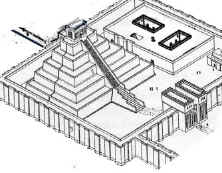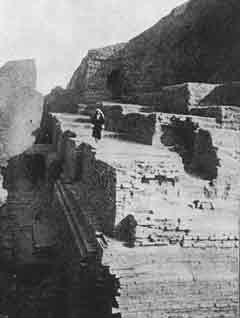Before the
Legend of Noah
|
|

Reconstruction of an ancient temple compound at Nippur founded by Ur Gur about 2800 BC. Construction and repairs continued until about 660 BC during the reign of Assyrian king Ashurbanipal.
19th century photo of the ziggurat at Nippur after removal of sand that covered it. Websites by David Hall: |
ACCORDING
TO AN INSCRIBED CLAY TABLET DISCOVERED IN NIPPUR, IRAQ BY AN AMERICAN EXPEDITION 1883 - 1886; A MAN AND HIS FAMILY SURVIVED A CATASTROPHIC FLOOD BY RECEIVING ADVANCED WARNING FROM GOD, PROBABLY BEFORE 1800 BC. In ancient Mesopotamia writing was in use by about 3000 BC. The writings of ancient scholars were preserved on clay tablets. The ancient scribe formed a rectangular piece of clay and used a pointed stick to form characters in the soft clay. Some of the tablets were sun dried and placed on shelves or in pottery jars. Others were fired in pottery kilns and fired rock hard to make sure the valuable records might not be lost. The first writings seem to have been inventory records such as the amounts or types of items stored in clay jars. By 2000 BC there were shipping records describing maritime trade between the Persian Gulf coastal areas of Iraq, Bahrain, Oman, the Indian Ocean coasts of Pakistan, and the west coast of India (Lothal). The ancients sailed in huge reed bundle sailing boats in the Persian Gulf as described by anthropologist Thor Heyerdahl in THE TIGRIS EXPEDITION. Reed boats may have been in use by 5000 BC. Early records indicate shipping trade of copper between Iraq and Oman as early as 2300 BC. The University of Pennsylvania (US) sent an expedition to Nippur, Iraq between 1883-1886. During later parts of the Nippur excavations J.H. Haynes was the only UPA staff member on site supervising up to about 150 or more Arab supervisors, guards, and laborers. They uncovered tens of thousands of tablets in the temple precinct (see photo to left). Mesopotamian scribes had recorded surveys of fields, the amounts of grain produced per field, the volume of grain required to feed the oxen in order to plow the fields, and the amount of grain given to the plow servants. There were accounts of the number of sheep owned by the temple in various flocks, whether these were ewes, lambs, or rams, and who the shepherd responsible for each flock was. There were lists describing the number of sheep delivered for sacrifice and a six foot altar found near the base of the temple pavement constructed during the time of Ur Gur c. 2100 BC. Haynes found half a foot of compressed ashes near a six foot sacrificial altar uncovered after extensive excavation of overburden. The entire region between the Euphrates and Tigris Rivers of Iraq was dependent on canals for irrigation and shipping of freight. There was a myth recorded on a tablet about a time when it was the gods who dug the canals. One day the gods threw down their pick axes and exclaimed that men should do the digging. The working men may have resented the way the temple establishment lived in luxury while they were worn down by the hardships of their labor. There was a tablet from Nippur describing a god having advance knowledge of a coming torrential downpour and subsequent flooding. God liked people and warned a man about the coming flood. The man was commanded to build a boat in order to save his life. It was dated to a time before the Bible was written. Numerous early versions of the flood legend exist. The Flood Legend Tablets Life Along The River Map Conclusion |
| Israel
Photos Israel Photos II Israel Photos III Israel
Photos IV You may use text and images from this flood legend website for non-profit use. |
|
|
|
|
